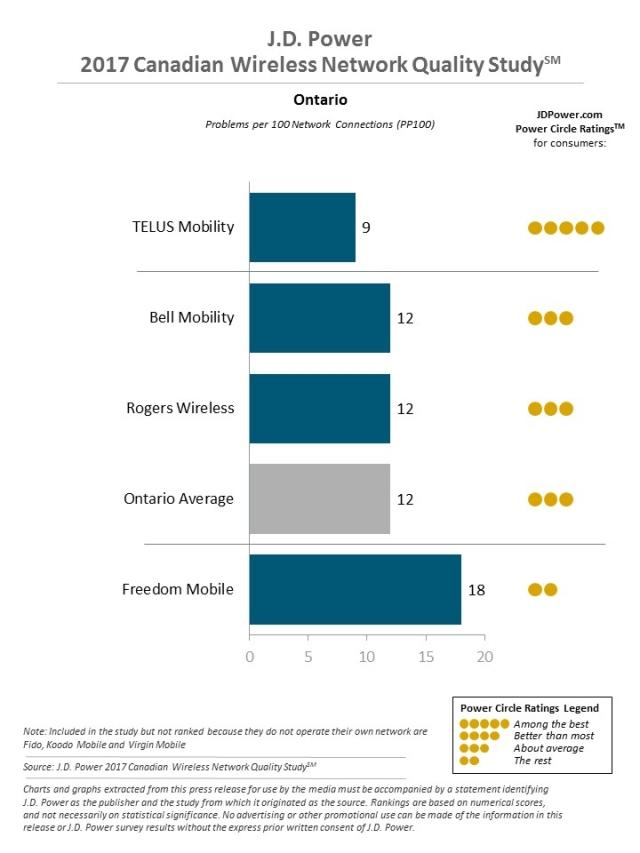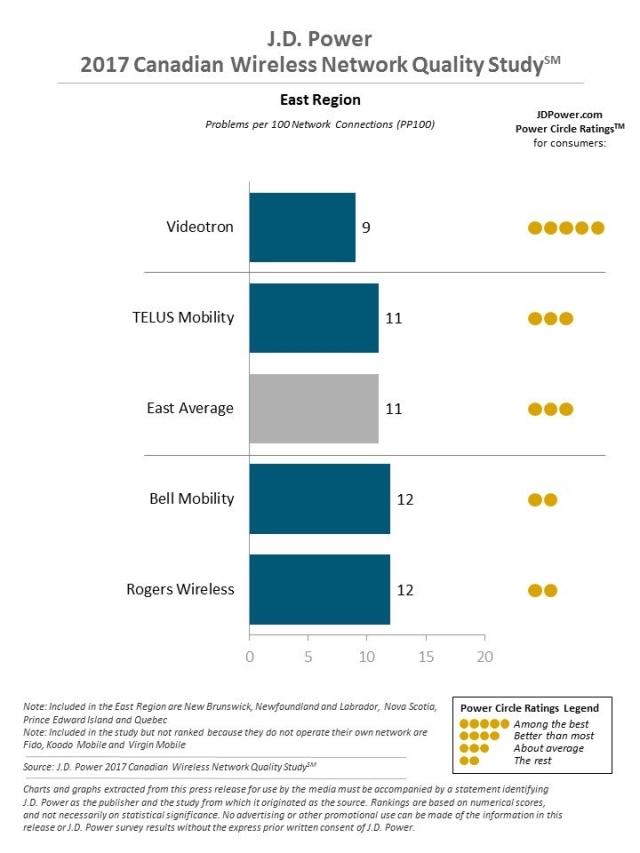Incidence of Wireless Network Problems Increases with Usage, J.D. Power Finds
TELUS Mobility Ranks Highest in Wireless Network Quality Performance in the West Region and Ontario; Videotron Ranks Highest in East Region
TORONTO: 25 May 2017— Heavy users of wireless service in Canada cite higher incidences of network problems than do lighter users, according to the J.D. Power 2017 Canadian Wireless Network Quality Study,SM released today.
Heavy users1 of wireless service experience an average of 14 problems per 100 connections (PP100), compared with 12 PP100 among medium users and 10 PP100 among light users. Within all major network problem categories—calling, messaging and data—problem incidence increases as usage increases. Data problems continue to account for most of the network issues experienced.
“The tasks performed by heavy users can represent a significant strain on carrier networks,” said Adrian Chung, director at J.D. Power. “Plus, the frequent consumption of services by this group means more recent and top-of-mind experiences. Carriers can expect to elevate the customer experience at all user levels if they focus on the needs of their heaviest users, who are most sensitive to problems, while simultaneously enhancing the device experience.”
Following are some additional findings of the 2017 study:
- Younger customers experience more network problems: On average, customers ages 18-34 experience 14 PP100 compared with 12 PP100 among those ages 35-44; 10 PP100 among those 45-54; 9 PP100 among those 55-64; and 7 PP100 among those 65 or older.
- When texting increases, talking decreases: Text messages account for 56% of all wireless connections among heavy users, compared with 49% among medium users and 40% among light users. Voice and voicemail connections account for only 7% of the connections of heavy users vs. 12% among medium users and 28% among light users.
- Heavier users have higher data allowances and monthly bills: More than one-third (35%) of heavy users have a monthly data allowance of 5 GB or more, compared with 26% of medium users and 22% of light users. Heavy users have average monthly service bills of $104 vs. $93 among medium users and $76 among light users.
- Fewer customers indicate slow 4G data speeds: Only 11% of customers say data speeds on their 4G phone are slower than expected, down from 13% in 2016. However, the percentage of customers who say data speeds are faster than expected has remained stable from last year, at 9%.
Study Rankings
In the East region, Videotron (9 PP100) ranks highest in overall network quality, followed by TELUS Mobility (11 PP100), which receives the region average score.
In Ontario, TELUS Mobility (9 PP100) ranks highest in overall network quality, while Bell Mobility and Rogers Wireless each rank second and receive the region average score (12 PP100).
In the West region, TELUS Mobility (9 PP100) ranks highest in overall network quality, followed by SaskTel (10 PP100).
The 2017 Canadian Wireless Network Quality Study was conducted online in English and French. The study, which measures problems per 100 connections (PP100), includes seven wireless carriers in the East region; seven wireless carriers in Ontario; and nine wireless carriers in the West region. The study is based on 15,021 responses and was fielded in September-October 2016 and March 2017.
Media Relations Contacts
Gal Wilder, Cohn & Wolfe, Toronto, Canada; 647-259-3261, gal.wilder@cohnwolfe.ca
Jennifer McCarthy, Cohn & Wolfe, Toronto, Canada; 647-259-3305, jennifer.mccarthy@cohnwolfe.ca
Geno Effler, J.D. Power, Costa Mesa, Calif.; 714-621-6224, media.relations@jdpa.com
For information about the Canadian Wireless Network Quality Study, visit http://canada.jdpower.com/industry/telecom-ca
See the online press release at http://www.jdpower.com/pr-id/2017068
About J.D. Power and Advertising/Promotional Rules http://www.jdpower.com/about-us/press-release-info
__________
1Heavy users had at least 150 connections on their wireless device in the previous 48 hours (e.g., voice, messaging, data connections); medium users had between 75 and 149 connections; light users had fewer than 75 connections.


